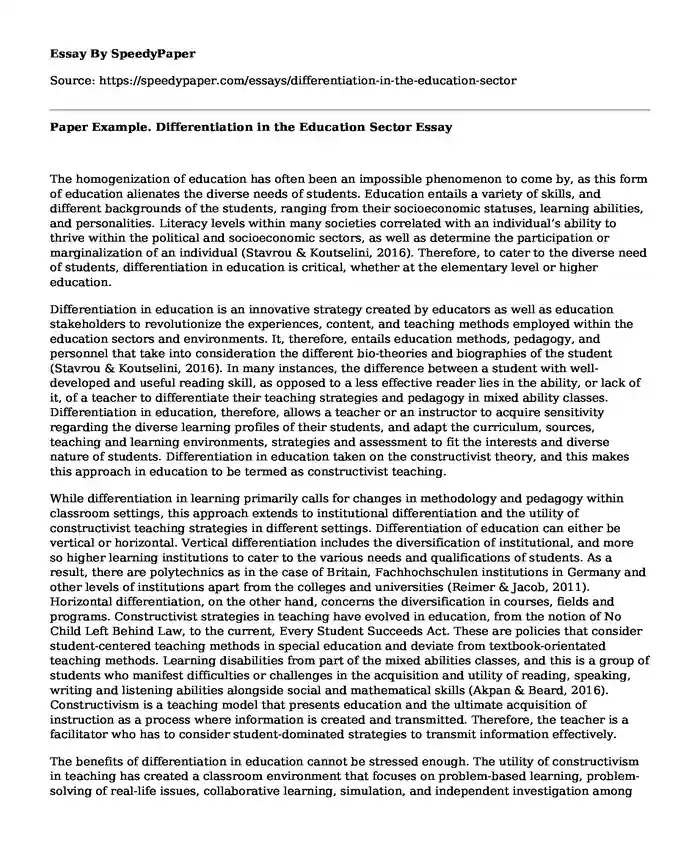
| Essay type: | Problem solution essays |
| Categories: | Teaching Learning Students Diversity |
| Pages: | 3 |
| Wordcount: | 694 words |
The homogenization of education has often been an impossible phenomenon to come by, as this form of education alienates the diverse needs of students. Education entails a variety of skills, and different backgrounds of the students, ranging from their socioeconomic statuses, learning abilities, and personalities. Literacy levels within many societies correlated with an individual’s ability to thrive within the political and socioeconomic sectors, as well as determine the participation or marginalization of an individual (Stavrou & Koutselini, 2016). Therefore, to cater to the diverse need of students, differentiation in education is critical, whether at the elementary level or higher education.
Differentiation in education is an innovative strategy created by educators as well as education stakeholders to revolutionize the experiences, content, and teaching methods employed within the education sectors and environments. It, therefore, entails education methods, pedagogy, and personnel that take into consideration the different bio-theories and biographies of the student (Stavrou & Koutselini, 2016). In many instances, the difference between a student with well-developed and useful reading skill, as opposed to a less effective reader lies in the ability, or lack of it, of a teacher to differentiate their teaching strategies and pedagogy in mixed ability classes. Differentiation in education, therefore, allows a teacher or an instructor to acquire sensitivity regarding the diverse learning profiles of their students, and adapt the curriculum, sources, teaching and learning environments, strategies and assessment to fit the interests and diverse nature of students. Differentiation in education taken on the constructivist theory, and this makes this approach in education to be termed as constructivist teaching.
While differentiation in learning primarily calls for changes in methodology and pedagogy within classroom settings, this approach extends to institutional differentiation and the utility of constructivist teaching strategies in different settings. Differentiation of education can either be vertical or horizontal. Vertical differentiation includes the diversification of institutional, and more so higher learning institutions to cater to the various needs and qualifications of students. As a result, there are polytechnics as in the case of Britain, Fachhochschulen institutions in Germany and other levels of institutions apart from the colleges and universities (Reimer & Jacob, 2011). Horizontal differentiation, on the other hand, concerns the diversification in courses, fields and programs. Constructivist strategies in teaching have evolved in education, from the notion of No Child Left Behind Law, to the current, Every Student Succeeds Act. These are policies that consider student-centered teaching methods in special education and deviate from textbook-orientated teaching methods. Learning disabilities from part of the mixed abilities classes, and this is a group of students who manifest difficulties or challenges in the acquisition and utility of reading, speaking, writing and listening abilities alongside social and mathematical skills (Akpan & Beard, 2016). Constructivism is a teaching model that presents education and the ultimate acquisition of instruction as a process where information is created and transmitted. Therefore, the teacher is a facilitator who has to consider student-dominated strategies to transmit information effectively.
The benefits of differentiation in education cannot be stressed enough. The utility of constructivism in teaching has created a classroom environment that focuses on problem-based learning, problem-solving of real-life issues, collaborative learning, simulation, and independent investigation among other skills (Akpan & Beard, 2016). However, vertical differentiation can result in unexpected negative impacts, more so on the individual level. With institutions differentiated to cater to the varying needs of students, there are cases where students from less privileged backgrounds get low tiers in terms of programs and career choices.
Generally, differentiation in education is a critical model in revolutionizing education outcomes and ensuring the attainment of equality. This model incorporates the constructivist approach to personalize pedagogy to cater to the interest, needs, and diversities of students.
References
Akpan J. P. & Beard L. A. (2016). Using Constructivist Teaching Strategies to Enhance Academic Outcomes of Students with Special Needs. Universal Journal of Educational Research 4(2). Pp. 392-398. DOI: 10.13189/ujer.2016.040211
Reamer D. & Jacob M. (2011). Differentiation in higher education and its consequences for social inequality: introduction to a special issue. Higher Education, 61. Pp.223–227 DOI 10.1007/s10734-010-9373-z
Stavrou T. E. & Koutselini M. (2016). Differentiation of Teaching and Learning: The Teachers' Perspective. Universal journal of educational research, 4(11). Pp. 2581-2588. DOI: 10.13189/ujer.2016.041111
Cite this page
Paper Example. Differentiation in the Education Sector. (2023, Aug 22). Retrieved from https://speedypaper.net/essays/differentiation-in-the-education-sector
Request Removal
If you are the original author of this essay and no longer wish to have it published on the SpeedyPaper website, please click below to request its removal:
- Free Essay on How to Write a Personal Statement for College
- Essay Sample: Advantages and Disadvantages of the Electoral College
- Article Review Sample: Retention Initiatives for Working Adult Students in Accelerated Programs
- Depiction of Race and Ethnicity Figure in Media - Essay Example
- Paper Example on the Community of Hong Kong
- Essay on Personality & Jealousy: Low Self-Esteem & Gender Differences
- Free Essay Example: Race, Gender, Clan, and Class in Art
Popular categories




